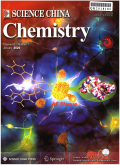- 钛学术文献服务平台 \
- 学术期刊 \
- 基础科学期刊 \
- 自然科学总论期刊 \
- 中国科学:化学(英文版)期刊 \
Calculation aided miscibility manipulation enables highly efficient polythiophene:nonfullerene photovoltaic cells
Calculation aided miscibility manipulation enables highly efficient polythiophene:nonfullerene photovoltaic cells
基本信息来源于合作网站,原文需代理用户跳转至来源网站获取
摘要:
Polythiophenes,with merits of low cost and high scalability of synthesis,have received growing interest in organic solar cells.To date,the best-performing polythiophene:nonfullerene solar cells exhibit typical power conversion efficiencies (PCEs) of 10%-12%,which is much lower than those employing PM6-and D 18-type polymers.This inferior performance is mostly limited by the improper miscibility between polythiophene and acceptors.Efforts on engineering the molecular structure to systematically tune the miscibility are required.With the aid of group contribution calculations,the miscibility of polythiophene:nonfullerene blend system was finely tuned by varying the ratios of siloxane-terminated chains and alkyl chains in ester-substituted polythiophenes through random copolymerization.Based on a series of the polythiophene and nonfullerene acceptors,the detailed analysis of blend miscibility and performance reveals a surprising anticorrelation between the Flory-Huggins interaction parameter (xaa) and the optimal time of solvent vapor annealing for device performance across these systems.Primarily due to the slightly higher xaa,the blend of PDCBT-C1-Si5 and ITIC-Thl results in a record-high PCE of 12.85% in polythiophene:nonfullerene solar cells.The results not only provide a calculation-guided approach for molecular design but also prove that precise control of the miscibility is an effective way to design high-performance polythiophene:nonfullerene blends and beyond.

推荐文章
Assessment of bacterial biomass in the highly contaminated urban Nanming River, Guiyang, SW China
δ13C
δ15N
Bacterial biomass
N budget
Nanming River
“biochemistry cells”生化学习互动程序设计的实践与思考
生物化学
学习互动程序
实践
Theoretical calculation of equilibrium Mg isotope fractionation between silicate melt and its vapor
Equilibrium Mg isotope fractionation
Force constant
Structural optimization
RPFR
内容分析
关键词云
关键词热度
相关文献总数
(/次)
(/年)
文献信息
| 篇名 | Calculation aided miscibility manipulation enables highly efficient polythiophene:nonfullerene photovoltaic cells | ||
| 来源期刊 | 中国科学:化学(英文版) | 学科 | |
| 关键词 | |||
| 年,卷(期) | 2021,(3) | 所属期刊栏目 | ARTICLES |
| 研究方向 | 页码范围 | 478-487 | |
| 页数 | 10页 | 分类号 | |
| 字数 | 语种 | 英文 | |
| DOI | |||
五维指标
引文网络
引文网络
二级参考文献 (0)
共引文献 (0)
参考文献 (1)
节点文献
引证文献 (0)
同被引文献 (0)
二级引证文献 (0)
2020(1)
- 参考文献(1)
- 二级参考文献(0)
2021(0)
- 参考文献(0)
- 二级参考文献(0)
- 引证文献(0)
- 二级引证文献(0)
引文网络交叉学科
相关学者/机构
期刊影响力
中国科学:化学(英文版)
主办单位:
中国科学院
出版周期:
月刊
ISSN:
1674-7291
CN:
11-5839/O6
开本:
16开
出版地:
北京东黄城根北街16号
邮发代号:
创刊时间:
1950
语种:
eng
出版文献量(篇)
4060
总下载数(次)
0
总被引数(次)
11421
期刊文献
相关文献
推荐文献
- 期刊分类
- 期刊(年)
- 期刊(期)
- 期刊推荐
力学
化学
地球物理学
地质学
基础科学综合
大学学报
天文学
天文学、地球科学
数学
气象学
海洋学
物理学
生物学
生物科学
自然地理学和测绘学
自然科学总论
自然科学理论与方法
资源科学
非线性科学与系统科学
中国科学:化学(英文版)2022
中国科学:化学(英文版)2021
中国科学:化学(英文版)2020
中国科学:化学(英文版)2019
中国科学:化学(英文版)2018
中国科学:化学(英文版)2017
中国科学:化学(英文版)2016
中国科学:化学(英文版)2015
中国科学:化学(英文版)2014
中国科学:化学(英文版)2013
中国科学:化学(英文版)2012
中国科学:化学(英文版)2011
中国科学:化学(英文版)2010
中国科学:化学(英文版)2009
中国科学:化学(英文版)2008
中国科学:化学(英文版)2007
中国科学:化学(英文版)2006
中国科学:化学(英文版)2005
中国科学:化学(英文版)2004
中国科学:化学(英文版)2003
中国科学:化学(英文版)2002
中国科学:化学(英文版)2001
中国科学:化学(英文版)2000
中国科学:化学(英文版)2021年第7期
中国科学:化学(英文版)2021年第6期
中国科学:化学(英文版)2021年第5期
中国科学:化学(英文版)2021年第4期
中国科学:化学(英文版)2021年第3期
中国科学:化学(英文版)2021年第2期
中国科学:化学(英文版)2021年第12期
中国科学:化学(英文版)2021年第11期
中国科学:化学(英文版)2021年第1期

 免费查重
免费查重










